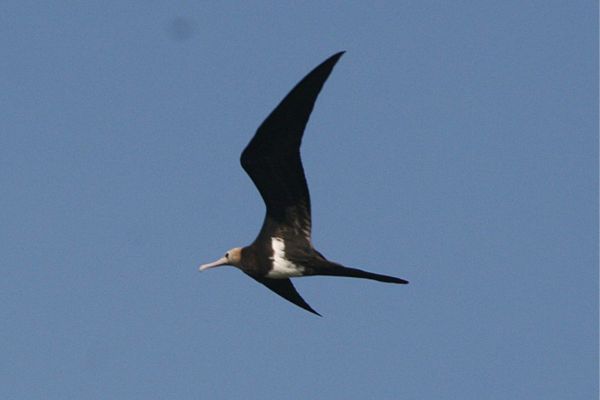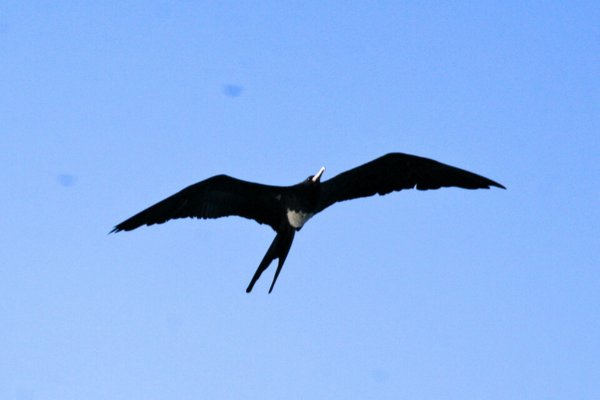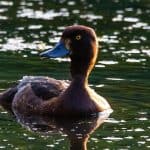Lesser frigatebird perching | image by Aviceda via Wikimedia Commons | CC BY 3.0
Common Name: Lesser Frigatebird
Scientific Name: (Fregata ariel)| Size | Diet | Range in Hawaii | Status in Hawaii |
|---|---|---|---|
| 35 in. - 40 in. | small fish, squid, and other marine delicacies | Kaua'i, O'ahu, and Maui | Least Concern |
The Lesser Frigatebird, also known as Fregata ariel, is a seabird species that is native to the tropical and subtropical regions of the world. While the species is not native to Hawaii, it has been known to make occasional appearances on the islands as a breeding visitor. With its distinctive appearance and graceful flight, the Lesser Frigatebird is a fascinating bird species that has captured the attention of birdwatchers and avian enthusiasts around the world.
In this article, we will explore the world of the Lesser Frigatebird, its unique characteristics, and its presence in Hawaii.
Lesser Frigatebird
Appearance

The Lesser Frigatebird is a captivating sight in the skies. Its glossy black feathers and impressive 35 to 40-inch wingspan command attention as it soars gracefully.
The male displays an inflatable, vibrant red gular pouch, adding a dash of drama to its already stunning appearance during courtship. This avian wonder showcases nature’s artistry at its finest.
Diet
The Lesser Frigatebird is a skillful and opportunistic hunter of the high seas. This seabird’s diet primarily consists of small fish, squid, and other marine delicacies. Its ability to snatch food from other creatures showcases its resourcefulness and adaptability in securing a meal.
Nesting
The nesting habits of the Lesser Frigatebird are a testament to both its resourcefulness and resilience in the challenging world of seabirds. Unlike many other species, these avian wonders choose to nest in colonies, often on remote and inaccessible islands, far away from human presence.
To create their nests, Frigatebirds employ a remarkable combination of aerial skills and crafty gathering. Males take the lead in nest construction, collecting various materials like twigs, leaves, and seaweed from the surrounding area. With precision and dexterity, they skillfully weave these elements into a bowl-shaped structure, showcasing their architectural expertise.
However, the scarcity of materials on these remote islands presents a challenge. To overcome this obstacle, the Lesser Frigatebird has a unique strategy. They often resort to stealing nesting materials from other seabirds, employing their kleptoparasitic tendencies once again. This behavior earned them the nickname “pirates of the skies.”
Once the nests are ready, females lay a single egg, and both parents take turns incubating it. The nesting period can be lengthy, and during this time, they fiercely defend their territories from potential intruders.
Interestingly, Frigatebird chicks have a prolonged dependency period compared to other bird species. They rely on their parents for an extended period before they can fledge and venture into the world on their own.
Behavior
One of their most remarkable behaviors is their prowess in flight. With their long, slender wings, they are true avian acrobats, performing intricate aerial maneuvers with ease. Their ability to stay aloft for extended periods is unparalleled among seabirds, making them the ultimate voyagers of the skies.
But it’s not just their flight that sets them apart. Lesser Frigatebirds have a distinct social hierarchy within their colonies. During the breeding season, males compete fiercely for territories and perform elaborate courtship displays to attract mates. One of the most striking features of the male is his inflatable red gular pouch, which he proudly displays like a badge of honor.
Their cooperative nature extends to their foraging strategies as well. When it comes to hunting for food, they often engage in “kleptoparasitism,” stealing prey from other birds in mid-air. This opportunistic behavior showcases their cunning and resourcefulness in securing a meal.
Despite their aerial prowess, Lesser Frigatebirds face unique challenges in nesting. They lack waterproof feathers, making them unable to dive into the water for food or fish for their young. Instead, they rely on food obtained through their piracy techniques or regurgitated by other seabirds.
Habitat

The Lesser Frigatebird prefers tropical and subtropical oceanic islands, where they roost, nest, and breed in remote, predator-free locations. They spend most of their lives in flight, soaring over open seas, and exhibit remarkable navigation skills to locate abundant food sources. Their habitat showcases pristine islands and untouched wilderness, making them true masters of the skies and the open ocean.
Range
The Lesser Frigatebird is a breeding visitor to the Hawaiian Islands, particularly the Northwestern Islands. It has been observed on islands like Kure, Green, Midway, Laysan, and French Frigate Shoals. While most records are of adult males, females have also been spotted.
Their presence has been documented from March to November, and they are occasionally seen soaring with Great Frigatebirds. Additionally, there have been occasional sightings on other Hawaiian islands, such as Kaua’i, O’ahu, and Maui, but they are rarer compared to the Northwestern Islands.
Conservation Status
The conservation status of the Lesser Frigatebird (Fregata ariel) is considered of “Least Concern” by the International Union for Conservation of Nature (IUCN). This implies that the species is not facing immediate threats to its survival and has a stable population.
Interesting Facts
1. Flying without landing
The Lesser Frigatebird has such a high wing-loading (weight-to-wing area ratio) that it cannot take off from water. Instead, it relies on its incredible aerial agility and rarely lands on the water’s surface, even for resting.
2. Energy-efficient hunting
By using their keen eyesight and exploiting the efforts of other seabirds, Lesser Frigatebirds save energy during hunting. By stealing food from others, they avoid the energy expenditure required for diving or fishing.
3. Cultural significance
In various cultures, the Lesser Frigatebird holds symbolic importance. For example, in some Pacific cultures, it is considered a guardian spirit or a messenger from the divine, adding a touch of mystique to its already intriguing existence.
4. Endurance without food
During long flights, Lesser Frigatebirds may go for extended periods without food. They have adapted to rely on their energy reserves and are equipped with specialized digestive systems that allow them to endure these extended fasts.
5. Vulnerability to pollution
Despite their “Least Concern” conservation status, Lesser Frigatebirds are still susceptible to threats such as marine pollution and plastic debris. Ingesting or getting entangled in plastic can have severe consequences for these birds and other marine wildlife.
Frequently Asked Questions
1. Can Lesser Frigatebirds rest on the water like other seabirds?
Due to their high wing-loading, Lesser Frigatebirds cannot take off from water, so they avoid landing on the water’s surface. Instead, they rely on their exceptional aerial agility and endurance.
2. How do Lesser Frigatebirds sleep during long flights?
Lesser Frigatebirds are capable of sleeping while flying. They rest one half of their brain at a time, known as unihemispheric sleep, allowing them to stay alert during flight while still getting the rest they need.
3. What is the difference between the Lesser Frigatebird and the Great Frigatebird?
The main difference between the Lesser Frigatebird (Fregata ariel) and the Great Frigatebird (Fregata minor) is their size. The Lesser Frigatebird is smaller, with a wingspan of approximately 35 to 40 inches, while the Great Frigatebird has a wingspan of around 85 to 90 inches.
Additionally, the Lesser Frigatebird has a white ring around its eye, while the Great Frigatebird has a red gular pouch in both males and females, which is larger and more colorful in males.
4. Can Lesser Frigatebirds swim or walk on land?
Unlike some other seabirds, Lesser Frigatebirds are not adapted for swimming or walking on land. Their feet are webbed, but they are primarily used for perching on branches or rocks rather than for swimming or walking.




